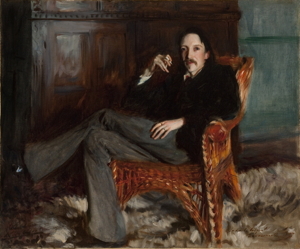
Robert Louis Stevenson by John Singer Sargent, 1887 (Copyright: Courtesy of the Taft Museum of Art, Cincinnati, Ohio)
The John Singer Sargent exhibition opening today (12 Feb) at the National Portrait Gallery brings together his two surviving Bournemouth paintings.
Both depict author Robert Louis Stevenson at home in Westbourne.
Sargent visited first in 1884 but the painting made on that occasion is lost.
The 1885 painting, lent from Arkansas, is called Robert Louis Stevenson and His Wife. Stevenson is standing in his bare boarded room which has just a rug. To one side sits his wife Fanny wearing, at her husband’s request, an Indian dress. Between the two is an exciting glimpse of the steep stairs and an outside door.
It is probable that Singer is trying to show Stevenson in one of his excitable moods which often led to him walking around when talking.
The house was Skerryvore in Alum Chine Road and the only good record of it is a drawing by Leslie Ward. The building was destroyed by Second World War bombing but its outline survives with the garden open to the public.
At this time in the mid 1880s the author was becoming well-known due to the recent publication of such books as Treasure Island.
The 1887 painting, lent from Ohio, was undertaken over just a few days in April. Stevenson was not well and sits in a wicker chair chain smoking as was his habit. By now his fame was greater following the release of Kidnapped the previous year.
The artist was also having success and that year took a studio in Chelsea’s Tite Street before being acclaimed during a visit to America.
In the 1885 picture, Fanny sits in the chair loved by Henry James whose later portrait is in the exhibition. The 1885 portrait, having been shown in London, returned to the Stevensons for a time and it was on a visit to Westbourne that James saw it on the wall.
The artist got to know Stevenson when he studied in Paris with his cousin Carolus-Duran whose portait is among around 70 on show.
An 1897 oil shows Mrs George Batten Singing. This is of interest since she later set up home with author Radclyffe Hall who had been born in Durley Road in 1880.
The poet Coventry Patmore is depicted near the end of his life when he was living in Lymington.
The Westbourne portraits are shown together. Henry James and Mrs Batten are next to each other.
The exhibition souvenirs on sale include a 70p postcard of the 1885 painting.
Sargent: Portraits of Artists and Friends is at the National Portrait Gallery in London’s Trafalgar Square daily until 25 May; admission £14.50 (conc £13).

